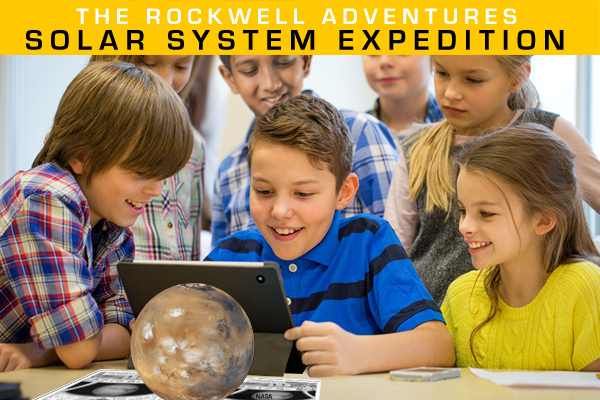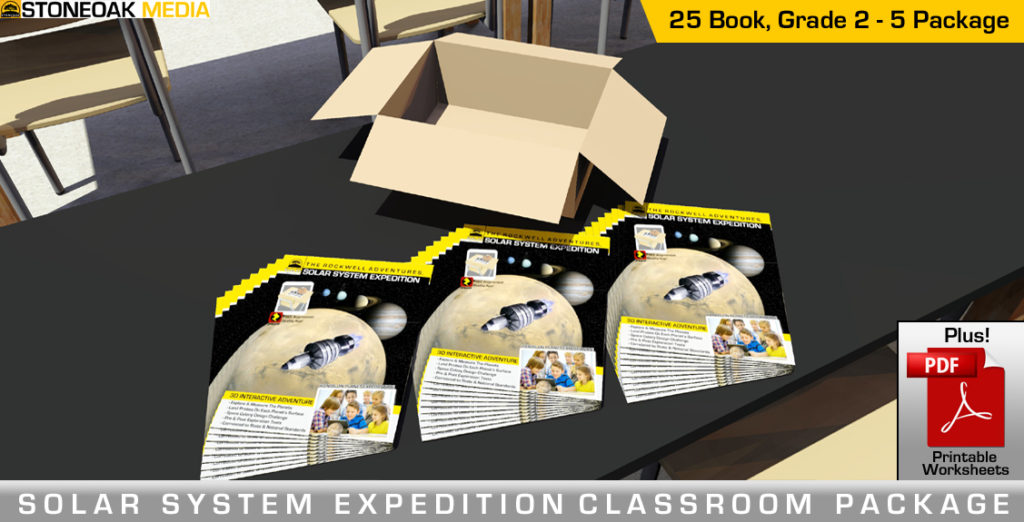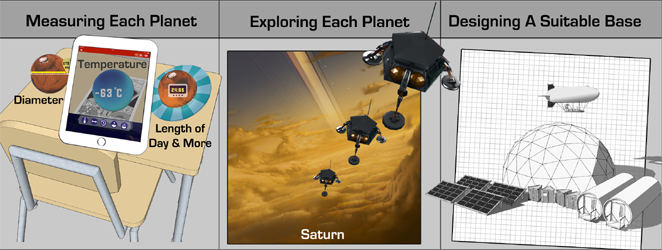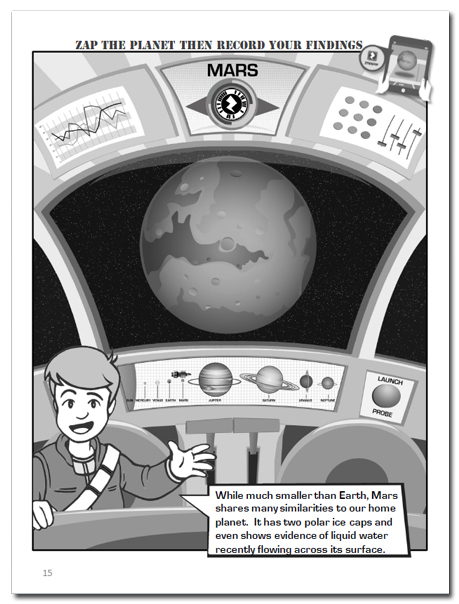Join the Rockwell family on their Top Secret mission to colonize a new planet. This fun-filled educational tour of the Solar System teaches students basic facts about each of the planets, and challenges them to design a base that is appropriate for the planet they choose to colonize.

Buckle up, and launch the following video to see the workbook in action!

Student Activity Books: Professionally printed and bound copies of this STEM-Focused, Augmented Reality enhanced educational activity book.
Teacher’s Manual: PDF versions of the Teacher’s Manual associated with this book. This manual includes easy to print copies of all worksheets that students will consume as part of the lesson.
This section contains Teacher’s Manuals for Solar System Expedition, as well as resources that the staff at StoneOak Media, and several collaborating educators have put together to enhance the basic lesson contained in these books. If you’re an educator that has developed extra content supporting these lesson, contact us today. We’re always looking for ways to expand the Solar System Expedition experience!
Note: To write a review, complete the form at the bottom of this page.
We’ve been using this lesson in our class for about 4 years, even during the pandemic. It really is the easiest way to teach students about the Solar System. The students also always get so excited about the design portions. Keep the great products coming!
Usei a demonstração gratuita e adorei!! Ótima experiência para os alunos!! Parabéns!
(Translation: I used the free demo and loved it!! Great experience for students!! Congratulations!)
Primary teacher in Sydney Australia here. My students love this lesson! We’ve used it for several years now, and the students get so excited about learning. We just ordered the Water Cycle books, and can’t wait to try them!
Brazil: Já usei o modelo gratuito com meus alunos e adorei! Gostaria que houvessem mais opções de usar gratuitamente nas escolas públicas do interior
(I’ve used the free template with my students and I loved it! I wish there were more options to use for free in public schools in the interior)
Thank you StoneOak Media, for making amazing science products like this available for FREE during the CV-19 crisis. My students, all of who are now learning remotely, have really taken learning to the next level with this book, and Water Cycle Engineer. They’ve been so EXCITED, when I speak with them after these lessons. THANK YOU!!!
The Rockwell Adventures – Solar System Expedition is the first book in the Rockwell Adventures Series. Designed for home, classroom, and library use, it takes students on a hands-on tour of the Solar System. State and national curriculum aligned STEM-focused student activities include:

On the page shown below, students are asked to measure various aspects of the planet Mars. Once completed, these measurements are then recorded by the students within the “Exploration Notes” page of the workbook (shown above). At the end of the overall lesson/mission, students are then asked to use these measurements and others as a guide to help them determine which planet they would like to build a base on. Once they’ve selected a planet, these measurements then serve as a guide to help students build the right kind of base.
To try this experience for yourself, simply install the FREE Zappar app (iOS / Android) on a tablet or smartphone, and follow these simple directions:


Each of our titles is $19.95/book. The accompanying Teacher’s Manual and Zappar augmented reality app are free. Books are normally sold as part of a package that contain enough copies so that each student/participant has their own book when completing the lesson. The lesson related posters shown above are included in these packages. Complete the form below to help us find the right solution for you.
Note: Reviews are typically published within 24 hours of submission.
K – 2nd Grade:
Grade 3:
Grade 4:
Grade 5:
Middle School (6-8)
Grade 1:
Grade 2:
Grade 3:
Grade 4:
Grade 5:
Grade 6:
Grade 7:
Grade 8:
Grade 2:
Physical Science: Properties of Matter
– 2.P.8.1: Observe and measure objects in terms of their properties, including size, shape, color, temperature, weight, texture, sinking or floating in water, and attraction and repulsion of magnets.
– 2.P.8.2: Identify objects and materials as solid, liquid, or gas.
Nature of Science: The Practice of Science
– 2.N.1.1: Raise questions about the natural world, investigate them in teams through free exploration and systematic observations, and generate appropriate explanations based on those explorations.
Grade 3:
Physical Science: Properties of Matter
– 3.P.8.1: Measure and compare temperatures of various samples of solids and liquids.
– 3.P.8.3: Compare materials and objects according to properties such as size, shape, color, texture, and hardness.
Nature of Science: The Practice of Science
– 3.N.1.1: Raise questions about the natural world, investigate them individually and in teams through free exploration and systematic investigations, and generate appropriate explanations based on those explorations.
– 3.N.1.3: Keep records as appropriate, such as pictorial, written, or simple charts and graphs, of investigations conducted.
Grade 5:
Physical Science: Properties of Matter:
– 5.P.8.1: Compare and contrast the basic properties of solids, liquids, and gases, such as mass, volume, color, texture, and temperature.
Earth and Space Science: Earth in Space and Time
– SC.5.E.5.2: Recognize the major common characteristics of all planets and compare/contrast the properties of inner and outer planets.
Nature of Science: The Practice of Science
– 5.N.1.1: Define a problem, use appropriate reference materials to support scientific understanding, plan and carry out scientific investigations of various types such as: systematic observations, experiments requiring the identification of variables, collecting and organizing data, interpreting data in charts, tables, and graphics, analyze information, make predictions, and defend conclusions.
Grade 8:
Earth and Space Science: Earth in Space and Time
– 8.E.5.3: Distinguish the hierarchical relationships between planets and other astronomical bodies relative to solar system, galaxy, and universe, including distance, size, and composition.
There are no upcoming events at this time